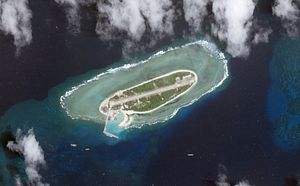What’s Taiwan building on Itu Aba?
The South China Morning Post, picking up on local Taiwanese reports, noted on Tuesday that “four concrete structures” were spotted on Itu Aba, the largest of the naturally formed features in the Spratly group in the South China Sea, occupied by Taiwan. The report adds that the structures are “about three to four storeys high” and “were found to have been built on the coastline of the west side of Taiping surrounding a circular structure still under construction on the shore.” Additionally, SCMP notes that the features were not visible in satellite imagery from January this year.
Some reports have started speculating that the structures are actually emplacements for anti-aircraft weaponry. Meanwhile, official Taiwanese sources are refusing to say much on the matter, prompting further speculation that Taipei is potentially doubling down on bolstering Itu Aba’s defenses in the aftermath of a July ruling on the South China Sea. Taiwan joined China in protesting the ruling, specifically disputing the five-judge arbitral tribunal’s finding that Itu Aba, despite being the largest naturally formed feature in the Spratly group, did not qualify as an “island” under the United Nations Convention on the Law of the Sea. (That means that Itu Aba is not entitled to a 200 nautical mile exclusive economic zone.)
“It is inconvenient for us to reveal any military facilities we are installing on Taiping Island and what their purposes are as they are all considered secrets,” Feng Shih-kuan, Taiwan’s defense minister, told reporters, using the Taiwanese name for the feature. He nonetheless added that “Taiping Island has strong [sic] defensive capability.” Confusing matters further, a Kuomintang legislator, Johnny Chiang Chi-chen, reportedly noted that he saw the structures in question during a trip to Itu Aba in the summer. Adding to the intrigue further, the China Post noted that Taiwan’s Coast Guard Administration had requested that Google blur satellite imagery of the structures on Itu Aba.
Whatever the structures are, they’re clearly sensitive and appear to have some security-related purpose. However, it’s unlikely that Taiwan would add surface-to-air missile batteries on Itu Aba in the aftermath of the ruling. It seems likelier that Taipei is looking to bolster its intelligence, surveillance, and reconnaissance capabilities around Itu Aba. Though Taipei has always stood by its position that Itu Aba should be recognized as a full-fledged island under international law, it hasn’t generally sought to restrict navigation in the territorial sea or contiguous zone of the feature. Improved ISR capabilities could indicate Taiwanese interest in more directly regulating foreign vessel activity in nearby waters. Finally, Taipei’s primary anti-air platforms, the Sky Bow (Tien Kung) series and Antelope batteries, feature road-mobile batteries.
Separately, with an intensification of activity in the South China Sea by China and other claimant states, Taipei could simply be trying to stay one step ahead of the competition. Earlier this year, in January, when the Asia Maritime Transparency Initiative’s Gregory Poling and the Manilla Bulletin’s José Abeto Zaide visited Itu Aba, becoming the first foreigners to do so in 15 years, neither acknowledged the possible presence of such structures or plans to establish any sort of anti-air facility near the west runway. (An image set released by AMTI does show existing an radar installation on Itu Aba.)
Whatever the structures, Taipei isn’t eager to offer transparency at this point. Taiwan’s reaction to the July 12 ruling was overwhelmingly negative, with the foreign ministry describing the finding on Itu Aba “completely unacceptable.” Taiwan has resolved to keep using Itu Aba is it did prior to the ruling and to support its fishermen in the nearby waters. An anti-aircraft emplacement on Itu Aba–though not entirely out of sync with what other claimants, including China and Vietnam have pursued in the South China Sea–would be an unexpected and provocative move by Taiwan. Until we have better evidence, it’s best not to rush to conclusions about Taiwan’s intentions.
Update: The Diplomat spoke to AMTI’s Gregory Poling who had the following to share on the structures: “Our imagery shows the four towers were built sometime after August 2015 and complete by January 2016. They’re visible in the [satellite] image we used for our interactive Itu Aba tour in March and were there when I visited the isle in February, though I didn’t see them.” Poling adds that the structures “could be defensive in nature, but can’t tell more than that from the image.”
“They’re not pointed toward the only break in the reef, which is south, so they’re not to prevent landings. They are oriented generally north by north west, which is toward both Subi [Reef] and the major north-south sea lane through the [South China Sea].”

































